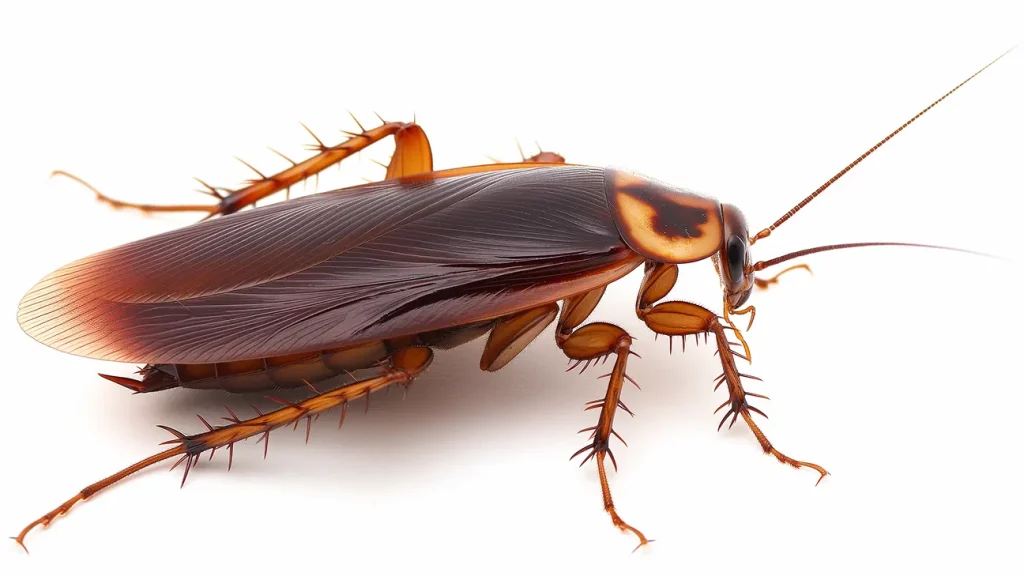
Cockroaches
Common types: German Cockroach, American Cockroach
Size: 1 inch long (22 to 27mm)
Life Span: 34 to 180 days
Cockroaches thrive in warm, humid environments with easy access to food and water. They prefer dark, secluded areas and often settle in basements, crawl spaces, and drains. Outdoors, they hide under pavements, in sewers, and beneath trash piles. While some species are fast and highly alert, oriental cockroaches move sluggishly and are less cautious than their counterparts. Males have wings covering most of their bodies but cannot fly, while females have only small wing pads. Their flattened bodies allow them to slip through narrow spaces, making them difficult to keep out.
These pests are nocturnal, spending daylight hours hidden and emerging at night to scavenge. They feed on decaying organic matter, garbage, and even non-food items such as paper and glue. In dry conditions, they can survive for weeks without food, but they need regular access to moisture. Since they reproduce quickly, infestations grow rapidly, leading to widespread contamination. Their presence is often detected through droppings, egg cases, and an unpleasant musty smell caused by the pheromones they release. These secretions allow them to communicate and attract others, worsening infestations if left unchecked.
As pest
Cockroaches pose serious health risks, primarily because they carry bacteria and allergens that contaminate food, utensils, and surfaces. They are known to spread pathogens such as Salmonella and E. Coli, which can cause food poisoning, gastrointestinal infections, and other illnesses. Their droppings, shed skin, and saliva contain proteins that can trigger allergic reactions and worsen asthma, particularly in children and individuals with respiratory conditions. Since they frequently move between garbage, sewage, and living spaces, they transfer harmful microbes wherever they crawl. Infestations are usually accompanied by visible cockroaches at night, an oily or musty odour, and dark brown egg cases. Each egg case contains multiple embryos, allowing populations to multiply rapidly.
Unlike other pests, cockroaches can develop resistance to pesticides, making them harder to eliminate. Their ability to adapt to various environments enables them to survive in homes, restaurants, hospitals, and warehouses. Businesses dealing with food storage and preparation are especially vulnerable, as infestations can lead to serious health code violations. If cockroaches are spotted during the daytime, it often indicates a large, well-established colony, as overcrowding forces some to emerge even when conditions are not ideal.

How to control
Effective cockroach control starts with cleanliness and eliminating food sources. Regularly sweeping, vacuuming, and wiping down surfaces remove crumbs and residues that attract them. Sealing entry points, such as cracks in walls, gaps around pipes, and loose window frames, help keep them out. Since they need moisture to survive, fixing leaky faucets and improving ventilation reduces their ability to thrive. Storing food in airtight containers and emptying trash bins frequently minimizes their access to nourishment. Roach baits, gel traps, and insect growth regulators are commonly used to target colonies.
However, since cockroaches can develop resistance to certain treatments, alternating control methods increase effectiveness. In severe infestations, professional extermination may be necessary, combining chemical treatments with long-term preventive measures. Natural deterrents like boric acid and diatomaceous earth provide additional control but work best when used alongside sanitation efforts. Regular monitoring is essential, as reinfestations can occur if conditions remain favourable. By maintaining a clean, dry environment and reducing hiding spots, it becomes much harder for cockroaches to settle and reproduce.

